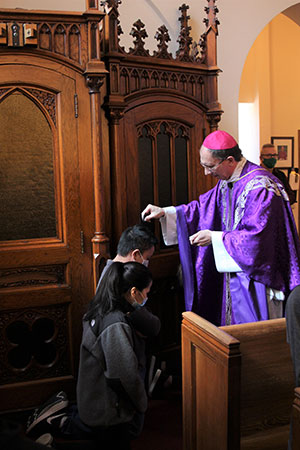 Parishes are being directed again this year to sprinkle ashes on the top of each person’s head rather than using them to make a cross on their forehead.
Parishes are being directed again this year to sprinkle ashes on the top of each person’s head rather than using them to make a cross on their forehead.
The practice – customary at the Vatican and in Italy but not as common in the U.S. – is similar to diocesan churches were instructed to do last year.
The U.S. Conference of Catholic Bishops has left guidelines for the distribution of ashes this year to the discretion of each bishop.
Priests may say “Repent, and believe in the Gospel” or “Remember that you are dust, and to dust you shall return” either to each person as they receive ashes or once to the entire congregation, a Feb. 18 instruction from the Diocese of Charlotte’s Office of Divine Worship noted.
The instruction also noted that face masks should not be worn during the imposition of ashes.
 Ash Wednesday marks the beginning of Lent and is a holy day of fasting and abstinence. Ashes are an ancient biblical sign meant as an outward demonstration of repentance for our sins and reminder of our mortality.
Ash Wednesday marks the beginning of Lent and is a holy day of fasting and abstinence. Ashes are an ancient biblical sign meant as an outward demonstration of repentance for our sins and reminder of our mortality.
— Catholic News Herald
Ash Wednesday customs
Ash Wednesday – March 2 this year – signals the start of Lent. It is a day of fasting and abstinence, although not a holy day of obligation.
ASHES
During Ash Wednesday services, ashes are sprinkled atop the head or marked on the forehead with the Sign of the Cross. The ashes are a symbol of penance and remind us that we are creatures of the earth and mortal beings: “For dust you are and to dust you shall return” (Gen 3:19).
The ashes, which help us to develop a spirit of humility and sacrifice, are made from the blessed palms used in the previous year’s Palm Sunday. The ashes are blessed with holy water. While the ashes symbolize penance and contrition, “they are also a reminder that God is gracious and merciful to those who call on Him with repentant hearts,” notes Catholic.org.
The customary use of ashes as a sign of repentance is seen in the Books of Jeremiah, Daniel and Jonah of the Old Testament. In the Book of Judith, acts of repentance involved ashes being put on people’s heads: “All the Israelites in Jerusalem, including women and children, lay prostrate in front of the Temple, and with ashes on their heads stretched out their hands before the Lord” (Judith 4:1).
The practice within the Church originated from a custom involving those who had committed serious sins. In the ancient Church, penitents expressed their humiliation by appearing in sackcloth and ashes. On Ash Wednesday they were presented to the bishop, clothed in sackcloth and barefooted. After the seven penitential psalms were sung, the bishop laid his hands on them, sprinkled them with holy water, and poured ashes upon their heads, declaring “that as Adam was cast out of paradise, so they, for their sins, were cast out of the Church. Then the inferior ministers expelled them out of the doors of the church. In the end of Lent, on the Thursday before Easter, they were presented for reconciliation,” according to the “Cyclopaedia of Biblical, Theological, and Ecclesiastical Literature” by John McClintock.
ALLELUIA
You might not have noticed, but the use of the word “Alleluia” is verboten during Lent. What is known as the “Alleluia verse” preceding the Gospel becomes known during Lent as “the verse before the Gospel,” with a variety of possible phrases to be used – none of which includes an alleluia.
The Alleluia was known for its melodic richness and in the early Church was considered to ornament the liturgy in a special way. In the spirit of the Lenten season of fasting, it was removed from Lenten Masses in the fifth or sixth century.
FASTING
Ash Wednesday is a day of abstinence and fasting; Good Friday is another. Abstinence means refraining from eating meat; fish is OK. Fasting means reducing one’s intake of food, such as eating two small meals that combined would not equal a full meal.
Fasting during Lent follows the example of Jesus’ 40-day fast in the wilderness. It also recalls the 40 days that Moses fasted on Sinai and the 40 days that Elijah fasted on his journey to Mount Horeb.
In the second century, Christians prepared for the feast of Easter with a two-day fast. This was extended to all of Holy Week in the third century. In 325, the Council of Nicaea spoke of a 40-day period of preparation for Easter as something already obvious and familiar to all.
— Sources: “Cyclopaedia of Biblical, Theological, and Ecclesiastical Literature,” by John McClintock, Catholic News Service, www.catholic.org


